The NVIDIA GeForce GTX 1650 Super Review, Feat. Zotac Gaming: Bringing Balance To 1080p
by Ryan Smith on December 20, 2019 9:00 AM ESTPower, Temperature, & Noise
Last, but not least of course, is our look at power, temperatures, and noise levels. While a high performing card is good in its own right, an excellent card can deliver great performance while also keeping power consumption and the resulting noise levels in check.
| GeForce Video Card Voltages | |||||
| 1650S Max | 1660 Max | 1650S Idle | 1660 Idle | ||
| 1.05v | 1.05v | 0.65v | 0.65v | ||
If you’ve seen one TU116 card, then you’ve seen them all as far as voltages are concerned. Even with this cut-down part, NVIDIA still lets the GTX 1650 Super run at up to 1.05v, allowing it to boost as high as 1950MHz.
| GeForce Video Card Average Clockspeeds | ||||
| Game | GTX 1660 | GTX 1650 Super | GTX 1650 | |
| Max Boost Clock | 1935MHz | 1950MHz | 1950MHz | |
| Boost Clock | 1785MHz | 1725MHz | 1695MHz | |
| Shadow of the Tomb Raider | 1875MHz | 1860MHz | 1845MHz | |
| F1 2019 | 1875MHz | 1875MHz | 1860MHz | |
| Assassion's Creed: Odyssey | 1890MHz | 1890MHz | 1905MHz | |
| Metro: Exodus | 1875MHz | 1875MHz | 1860MHz | |
| Strange Brigade | 1890MHz | 1860MHz | 1860MHz | |
| Total War: Three Kingdoms | 1875MHz | 1890MHz | 1875MHz | |
| The Division 2 | 1860MHz | 1830MHz | 1800MHz | |
| Grand Theft Auto V | 1890MHz | 1890MHz | 1905MHz | |
| Forza Horizon 4 | 1890MHz | 1875MHz | 1890MHz | |
Meanwhile the clockspeed situation looks relatively good for the GTX 1650 Super. Despite having a 20W lower TDP than the GTX 1660 and an official boost clock 60MHz lower, in practice our GTX 1650 Super card is typically within one step of the GTX 1660. This also keeps it fairly close to the original GTX 1650, which boosted higher in some cases and lower in others. In practice this means that the performance difference between the three cards is being driven almost entirely by the differences in CUDA core counts, as well as the use of GDDR6 in the GTX 1650 Super. Clockspeeds don’t seem to be a major factor here.
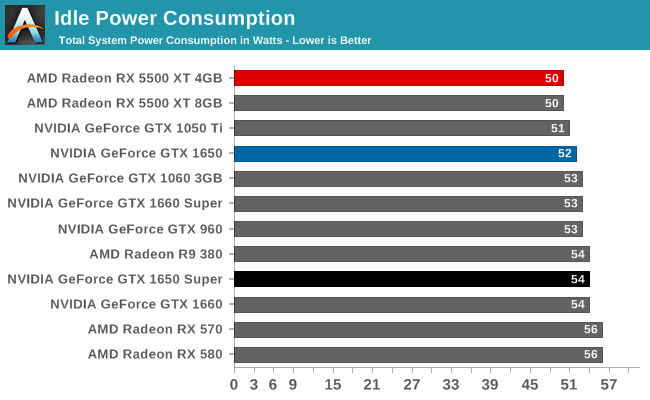
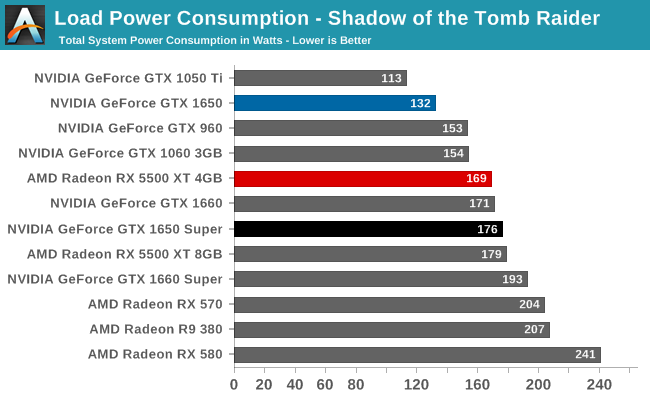

Shifting to power consumption, we see the cost of the GTX 1650 Super’s greater performance. It’s well ahead of the GTX 1650, but it’s pulling more power in the process. In fact I am a bit surprised by just how close it is (at the wall) to the GTX 1660, especially under Tomb Raider. While on paper it has a 20W lower TDP, in practice it actually fares a bit worse than the next level TU116 card. It’s only under FurMark, a pathological use case, that we see the GTX 1650 Super slot in under the GTX 1660. The net result is that the GTX 1650 Super seems to be somewhat inefficient, at least by NVIDIA standards. It doesn’t save a whole lot of power versus the GTX 1660 series, despite the lower performance.
Which also means it doesn’t fare especially well against the Radeon RX 5500 XT series. As with the GTX 1660, the RX 5500 XT is drawing less power than the GTX 1650 Super under Tomb Raider. It’s only by maxing out all of the cards with FurMark that the GTX 1650 Super pulls ahead. In practice I expect real world conditions to be between these two values – Tomb Raider may be a bit too hard on these low-end cards – but regardless, this would put GTX 1650 Super only marginally ahead of RX 5500 XT.
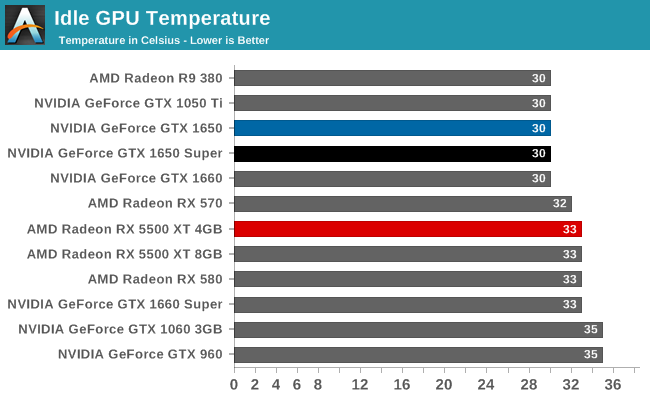
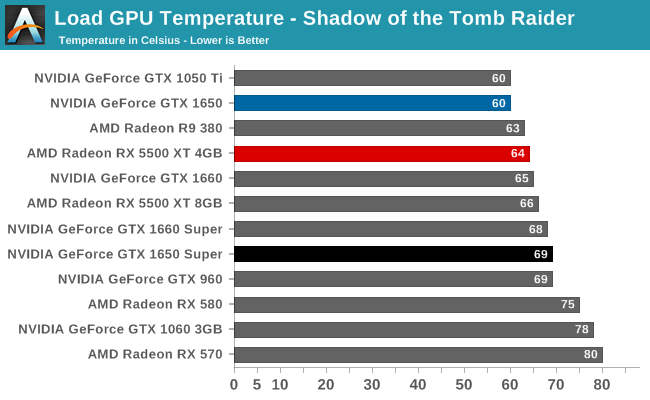
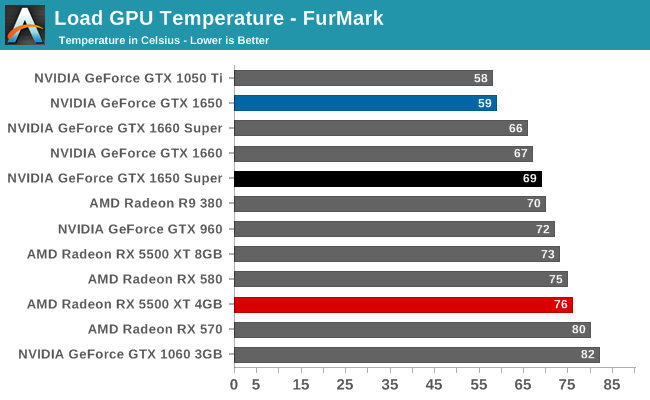
Looking at GPU temperatures, Zotac’s GTX 1650 Super card puts up decent numbers. While the 100W card understandably gets warmer than it’s 75W GTX 1650 sibling, we never see the GPU temperatures cross 70C. The card is keeping plenty cool.

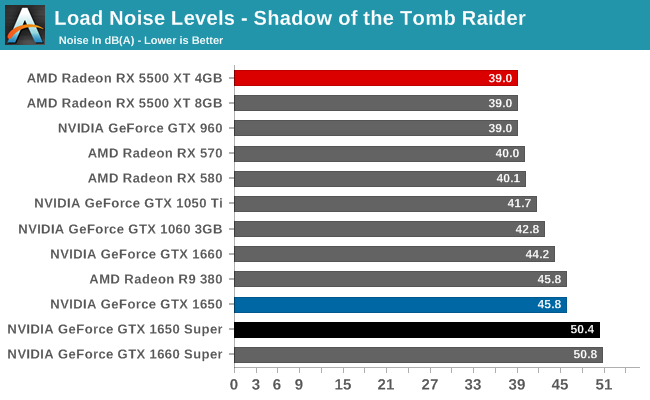

But when it comes time to measure how much noise the card is producing, we find a different picture. In order to keep the GPU at 69C, the Zotac GTX 1650 Super’s fans are having to do some real work. And unfortunately, the small 65mm fans just aren’t very quiet once they have to spin up. To be sure, the fans as a whole aren’t anywhere near max load – we recorded just 55% as reported by NVIDIA’s drivers – however this is still enough to push noise levels over 50 dB(A).
Zotac’s single-fan GTX 1650 card didn’t fare especially well here either, but by the time we reach FurMark, the GTX 1650 Super does even worse. It’s louder than any GTX 1660 card we’ve tested, even marginally exceeding the GTX 1660 Super.
All of this makes for an interesting competitive dichotomy given last week’s launch of the Radeon RX 5500 XT. The card we test there, Sapphire’s Pulse RX 5500 XT, is almost absurd in how overbuilt it is for a 130W product, with a massive heatsink and equally massive fans. But it moves more heat than Zotac’s GTX 1650 Super with a fraction of the noise.
If nothing else, this is a perfect example of the trade-offs that Sapphire and Zotac made with their respective cards. Zotac opted to maximize compatibility so that the GTX 1650 Super would fit in virtually any machine that the GTX 1650 (vanilla) can fit in, at the cost of having to use a relatively puny cooler. Sapphire went the other direction, making a card that’s hard to fit in some machines, but barely has to work at all to keep itself cool. Ultimately neither approach is the consistently better one – despite its noise advantage, the Sapphire card’s superiority ends the moment it can’t fit in a system – underscoring the need for multiple partners (or at least m multiple board designs). Still, it’s hard to imagine that Zotac couldn’t have done at least a bit better here; a 50 dB(A) card is not particularly desirable, especially for as something as low-powered as a GTX 1650 series card.










67 Comments
View All Comments
Korguz - Monday, December 23, 2019 - link
i still disagree... still more usefull then the vga connector.. and i bet displayport kvms.. are quite expensive compared to dvi kvms.....NetMage - Sunday, January 5, 2020 - link
You would lose that bet - StarTech.com had DisplayPort KVM about the same price as DVI.NetMage - Sunday, January 5, 2020 - link
The problem with DisplayPort KVMs is that Windows has hot plug enabled for DP and it can’t be disabled, which means switching one monitor in multi monitor setups can cause windows to rearrange, and cause difficulty with RDP.Fujikoma - Wednesday, December 25, 2019 - link
Old connectors have their place because there are people out there that can't just afford to buy a new computer simply to keep up and replacing a specific component is all that is needed. These people usually surf the internet, watch YouTube and look at pictures family send them. They don't need a new monitor with a new connector just because a more modern video card "shouldn't" have an old connector.29a - Friday, December 20, 2019 - link
I agree, give us more data. I'd like to see the codec ASICs start getting tested too.milkywayer - Friday, December 20, 2019 - link
Yup. I'd like to replace my massive and heavy evga gtx 1080ti with something smaller in size just so I can play indies and light weight games like LoL at 4k. I don't care about playing the latest AAA title at highest quality in 1080pCalihan - Saturday, December 21, 2019 - link
Trade my 970 for your 1080tiWetKneeHouston - Monday, January 20, 2020 - link
I'm with you. I think highest quality settings are a mirage anyway.Ryan Smith - Monday, December 23, 2019 - link
Thanks for the feedback.I'm hesitant to commit to anything at this second as adding resolutions would significantly increase the workload required in testing these cards (each run at one resolution is around 2 hours these days). So I hope you can understand why. But it's definitely something I'll be mulling over for GPU Bench 2020.
eastcoast_pete - Friday, December 20, 2019 - link
Thanks Ryan! Especially appreciate confirmation of the updated NVENC ASIC in the 1650 Super. Turing's NVENC is notably better than Pascal's, and makes this card potentially interesting for video encoding duties.